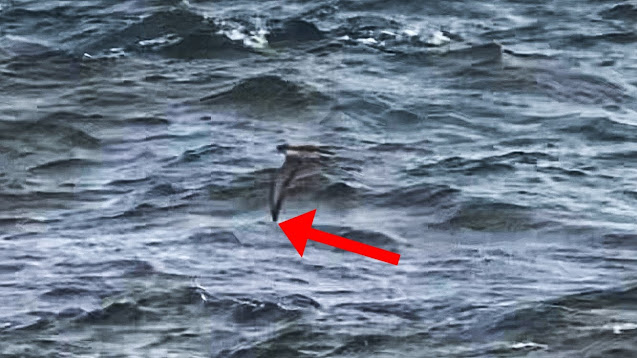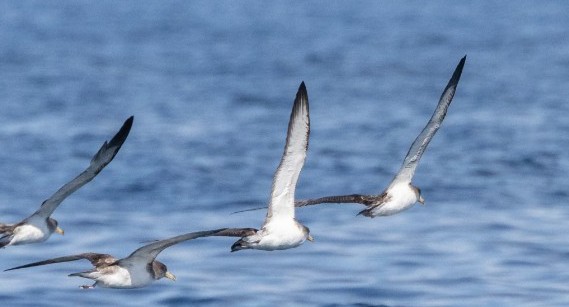Scoring Scopoli's - A useful ID pointer and assessment of Irish birds to date
A recent thread on birdforum got me thinking about Scopoli's Shearwater again.
Seemingly in response to a real assessment of the image quality of this "claim", McFlushkey seems to be presenting comparison images with a Cory's...in completely different lighting, sea state etc...🤦 Baffling really...Does he actually think these are comparable? Or is it pure desperation?
Plenty of time yet. Hopefully the trend continues and more seabirds give themselves up for the paparazzi.
The original poster provided two images for ID, with one suspected of being a Scopoli's (top here) and obviously so, and the other a Cory's in similar conditions.
After years of watching both Scopoli's and Cory's in seawatching conditions (rather than from pelagics) I was of the opinion that Scopoli's often has an appearance of having a narrower, paler more broken leading edge to the hand between the carpal joint and the base of P10.
So I decided to run an image survey of both Scopoli's and Cory's to try and assess this. (Fair use applies to all images used here).
Quantification of these things can be difficult, but I attempted to apply a scoring system, between 0 and 3 to the primary lesser and median coverts, and the marginal coverts in terms of "thickness" (i.e how far dark feathering extended towards the median of greater primary coverts, and "density" i.e. how black and widespread these feather tracts were on a whole, leading to the impression of a dark hand region, or where these tracts broken, interspersed with white or fringed white (less dense).
Birds like these Scopoli's scored low in both thickness and density as examples.
I will add all sorts of caveats here right at the outset. This is a quick and dirty analysis. Images are of course affected by all manner of parameters, including lighting and post processing etc.
I have endeavoured to ensure that all my samples were correctly identified however, and that there's no duplicate individuals (though I won't swear in court on that).
I post merely as a pointer. A search image feature that may help seawatchers ( I hope). I will leave it to seabird researchers to grill skins, or to go and try obtain sets of images of birds, ideally where both species are congregating in numbers under the same viewing conditions for the sake of robustness.
My sample set for Scopoli's numbered 128 individuals.
My sample set for Cory's numbered 153 individuals.
The average combined score for both parameters for Scopoli's was 2.0
The average combined score for both parameters from Cory's was 3.2
So some apparent difference between the two species is obviously there.
How did that break down?
Well as you might think, Scopoli's was heavily weighted to the lighter side of the spectrum. 10.9% scored zero values in thickness, 21.1% scored zero values on density.
69.5% scored a One on thickness and 63.3% scored a One on density. (Note, these values did not always align. I.e. a value of One for density could have a value of 2 for thickness etc.)
What this does suggest however is that Scopoli's does show a strong tendency to have a paler forewing on the underside of the hand, with perhaps 4 out of 5 individuals on the pale side of the problem.
How about Cory's then?
Well... Cory's is a much more variable beast, with a wider, more even spread of values. However it was noted that individuals with very narrow thickness were in short supply, with the weighting of birds scoring mostly One or Two for each parameter.
This of course means some serious overlap.
That said, there really is a je ne sais quoi when it comes to Scopoli's, a paleness and visual effect that really jumps out more than the number imply, and birds with virtually no black leading edge "should" be Scopoli's.
That said again, I would expect there to be exceptions out there, waiting to be snapped.
Indeed, I found outliers to some of the existing features. E.g. Scopoli's with a spot at the bases of both P10 and P9 exist.
How does this play out with Irish birds?
The first Irish Scopoli's off Cork, fulfilling all the ID criteria outlined by Flood et al, so checking the leading edge of the wing is somewhat unnecessary, but with a thickness scoring of about One and density markings of One also this does line up well.
Images by Paul Connaughton from Rare Bird Alert article.
The Bridges of Ross "claim" is more difficult to assess due to the poor quality of the images.
I had discussed this previously on the Band group when the news was put out.
(All images harvested from publicly available video on ebird and Vimeo)
Looking at this again in even greater detail, it's clear that you can't really even say where P10 is or P9 is and what is white and what isn't.
Indeed, the original images seem somewhat cherry picked, with the level of inter frame artefact and variability being extremely high between other frames in the video.
With none of the features really being assessable, I don't think this claim can pass muster, (however with the state of the IRBC nothing would surprise me any more).
The leading edge thickness change and warps between frames, but is consistently present at least. However, not to a degree where it can be scored reliably.
Edit: 11.08.2024
A recent Twitter post (I refuse to call it X 🤣) by Matthew Broadbent really highlights the issue with trying to call distantly photographed pale type Cory's. By far, Matthews images are better than McFlushkey's (less grainy etc.) and yet it's still hard to say whether those primaries are white or whether they are washed grey/beige (as many frames in McFlushkey's video are).
Images like this should drive home just how important it is for the general birding body to learn to assess information being presented to them, rather than just oohing and aahing.
The second Cork bird is a far better case, indeed, it's the best looking bird Ireland has had, again fulfilling the Flood ID criteria with ease.
Again the leading edge of the hand seems safely Scopoli's, with a thickness score of One and Density of One.
Scopoli's Shearwater by Stephen Dunbar
I would again stress that I believe this is a useful search image assist, but in no way any kind of silver bullet feature.
I do however think it's a useful one, and that seawatchers should focus on this region of the wing as an aid to possibly pick up interesting birds.
Comments welcome, so please post in the comments here, would love to hear from other seawatchers out there.
Edit: 28.08.2024
Since the previous iteration of this review post, claims of Scopoli's Shearwater off Ireland have exploded and it is now somewhat difficult to track numbers. The vast majority of these claims are seawatching claims from land, and as you may expect, have no images associated with them.
It does seem, however, that there has been a significant shift in the patterns of certain seabird species occurrence with notable increases, so perhaps this is now just the way of things and Scopoli's is on it's way to being a regular seawatching species off Ireland.
That said, let's continue to apply high standards of identification to the images that do pop up and assess them critically. Again, fair use applies to all.
I have to say, when it comes to all seabird images from the past couple of weeks, their quality has had my first thoughts go to the legendary John Hurt. 🤣
First up, an individual photographed by Ciaran Cronin off Galley Head, Co. Cork.
I know Galley very well...birds must have been very close to be able to get any image at all.
Scopoli's Shearwater - Galley Head, Ciaran Cronin
This strikes me like an old film image from some frontier 1980s pelagic 🙂...but despite the poor quality it seems to fit the bill.
No bar on the secondary coverts (nice when absent), relatively narrow leading edge to hand, and the primaries, despite some artefact and blur on the wing tip seem to be entirely white and we can reasonably estimate the differentiation point on where p10 and p9 should be, meaning it appears that the base of p10 should fulfil the flood requirements (though of course would be nice to see other frames if available.)
Poor image aside, this clears the bar.
Next up, one of the individuals from the Bridges of Ross, found and photographed by Aidan Kelly.
This one is a little tougher. But not by much. Clean secondary coverts (again, nice when there's nothing there), quite narrow leading edge to the hand (also nice when there).
The lower wingtip is showing blur/artefact leading to ambiguity but this is less pronounced on the upper wing tip, which appears, much like the Galley bird to be almost entirely white. None of your one or two white primaries for these two past birds, these seem to be very much in your face, full white wing tip individuals, which of course, are exactly what you want in a seawatching capacity.
The final candidate images by Brian McCloskey, again from the Bridges of Ross, however, are much less conclusive.
These images are even worse than those from 2023 unfortunately.
Worryingly they seem to show a pretty obvious grey wash to the primaries which does not inspire.
Most of the shots badly processed (originals all show a blindingly white body to the bird). Have tried to salvage as best I can and take that down a tad with the better ones below. Sadly, we are simply never going to nail p10 off images like this.
Update: 13/10/2024
Scopoli's Shearwater Photographed at Sea off Inisbofin, Co. Galway by Paul Kelly.
Scopoli's Shearwater - a more unusual bird, with a marking on the Primary covert of p9. This however is not unheard of in Scopoli's. All other primaries more than fulfil the Flood criteria, cementing ID as Scopoli's.
Leading edge of the hand, a score of 2, not the cleanest bird in this area.





















































Comments
Post a Comment